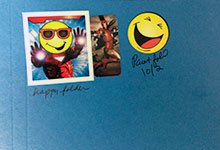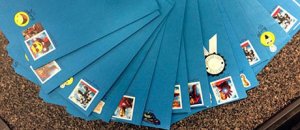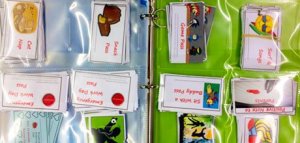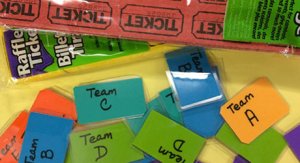5 Ways to Design Effective Rewards for Game-Based Learning
Learning by playing games can be a powerful way to teach. Just as drama coaches set the stage for a play, smart teachers set the stage for game-based learning. I use these five easy elements in my classroom to get my students ready to learn as they play.
Element #1: Stickers
As students turn in paperwork, anything praiseworthy earns "sticker bling" on their class folder. I use stickers to:
- Recognize students using classroom procedures: Stickers are my key method of procedure reinforcement during the first days of school. The "happy folder award" shown below is given when students do folder procedures perfectly.
- Recognize students who exceed expectations: I give several days for students to turn in signed papers, but "bling" goes to those who bring it back on day one.
- Rewards for participating in games or special achievements.
- Anything exceptional the student has done that is best kept private.
How do students know what stickers mean?

Inside the front cover of the folder, I date and write a note about why they earned a sticker. For example, if a student helps another student who is struggling, I might give him or her an Iron Man sticker and say: "I saw you help Johnny yesterday. You went over and above to be kind and helpful, and I appreciate your iron-strong leadership."
How do I make sure every student is included?
Be intentional about including and noticing every child. If a student doesn't have many stickers, pay attention and find something specific and genuine to praise. Since using this technique, my relationship with my more introverted students has skyrocketed.
What if you are paperless?
Class Dojo and LMS systems like Haiku Learning let teachers give badges online. I've found, however, that physical objects (like stickers on their binder or a folder) make games more fun, so if I give a badge online, I also give one face-to-face.

Element #2: The Student Reward Card
The WonderLab Student Appreciation card recognizes behavior that can be overheard. Here’s how:
- Noticing in-class accomplishment: Which is the first team to finish a challenge?
- Helping others: Students often tell me how their classmate deserves appreciation.
- Serving and helping the classroom: This includes handing out folders and facilitating class procedures.
- Recognizing accomplishment of a goal: If I want students on task faster, everyone who logs in and starts the lesson within one minute of the bell gets a punch.
How do students get recognized?
I verbalize why a student is receiving one of my coveted heart-shaped punches. This reinforces the behaviors I love: kindness, excellence, and a quest for knowledge.

What are the rewards?
My students design the rewards. I pick a reward time each week. Students caught up on work can redeem the certificate for 20 minutes or less. However, not all rewards take class time. RoseMary, an elementary teacher at my school, has "use a funny pen" and "go barefooted" rewards.

Element #3: The Crazy Prize Box
The Crazy Prize Box comes out for many team competitions including:
- Theme-based items for upcoming holidays
- Small trophies and medals
- Pedicure packs and sleep masks
- Airplanes, bouncy balls, and plastic lips
- Lots of goofy stuff!
How do students earn prizes?
The list above shows my "grand prizes." Students can pick anything from the box when they or their team wins. Sometimes this fits with a theme. For example, I do a zombie test prep day when gushy eyeballs are the prize.
Element #4: The Crazy Costume Cabinet
Good games have a storyline. Costumes help make players part of that story. My crazy costume cabinet includes:
- Discarded wigs (courtesy of parents and the drama department)
- Masks, hats, fairy wings, funny sunglasses, and crowns
- Beads, badges, and vests
- Anything I can buy for less than a dollar.
How do we use costumes?
When teams teach one another, they'll dress up in the theme they've concocted. Sometimes teams come up with a name and pick a special item to wear, like a feather in the hair or sheriff’s badge. Several weeks ago, students competed to perform the best "special news report" on a new technology. They dressed up as news anchors, Cajun chefs, and spies to share their stories. We laughed and learned!
Element #5 Ways to Split into Teams
Some teachers doom the possibility of learning without a fair, quick system for making teams. My team-making procedures include:
- Colored raffle tickets: Each team has a color. I draw to see the order in which students will play for their team.
- Colored candy (4-6 colors): I let them grab from a coffee mug as they enter and form into teams by colors.
- Laminated chips with the team names and/or colors
- Numbers, letters, and colors taped onto desks: Switch desks during the year or kids will keep getting the same partners.

How does this help?
You're teaching students procedures for splitting into teams in less than one minute.
But First, 2 Warnings
1. Don't reward anything and everything.
Partial reinforcement (when you get a reward some of the time) for behavior is better than full reinforcement (getting a reward every time). A heart-shaped punch or a sticker on a folder can diminish the nobility of a thoughtful gesture. Good teachers learn to honor the moment with the right response.
2. Grades are not rewards.
Grades are grades. Rewards are rewards. Keep them separate. I never use rewards for grades. Grades are private. Great grades are a reward for a job well done. That said, reward systems can impact grades in surprising ways. Last week, one student told me, "Mrs. Vicki, I have a great grade in your class because these punches motivate me to turn things in on time. The grades don't mean much to me, but I love getting the punch."
Wow!
Set the Stage
Set your own stage for game-based learning. What type of exciting reward system will you use? Can you have props? Can you have funny theme-based prizes ready to go? Are you ready to divide into teams?
If so, let's go. With these procedures in place, you're always ready to play a game. (Please see my next post for A Guide to Game-Based Learning.)
Will you share your game-based learning tools and techniques in the comments of this post? There are so many ways to spark excitement in the classroom!
